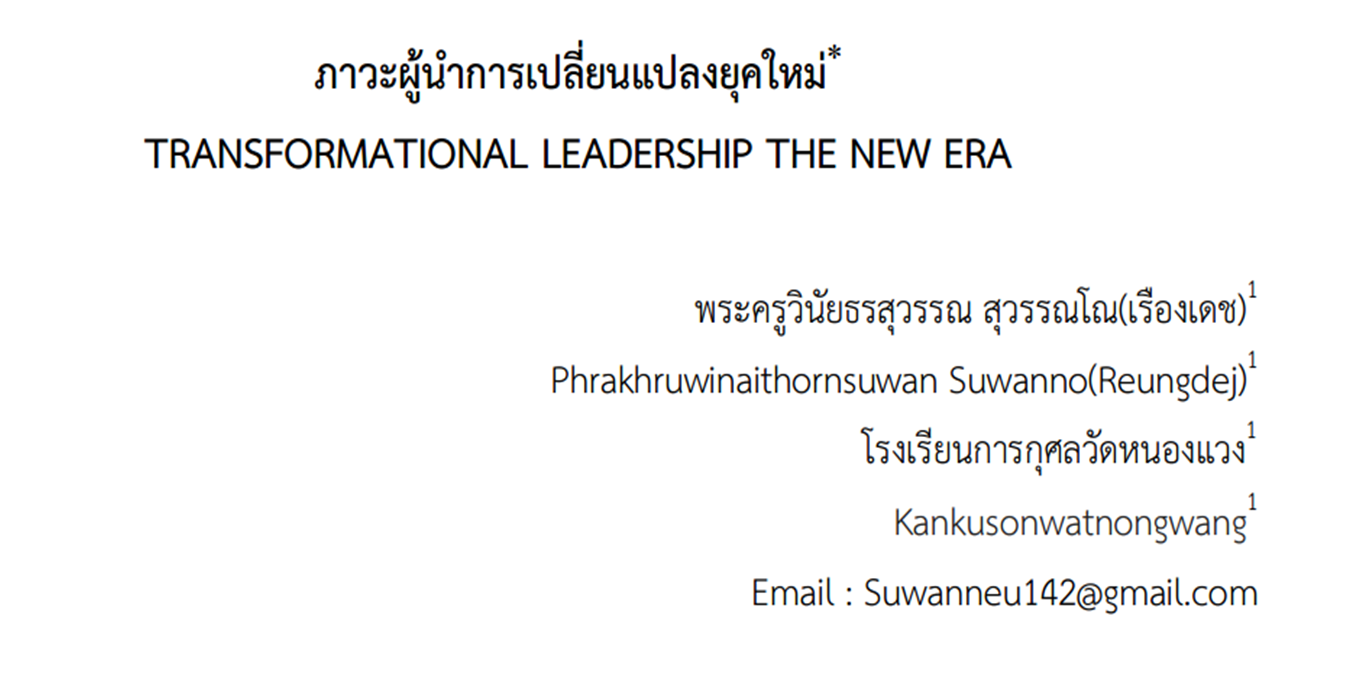ภาวะผู้นำการเปลี่ยนแปลงยุคใหม่
TRANSFORMATIONAL LEADERSHIP THE NEW ERA
Abstract
การเป็นผู้นำในเศรษฐกิจยุคใหม่ ย่อมมีความแตกต่างกันไปจากผู้นำในแบบเดิม การเป็นผู้นำในยุคนี้ควรเป็นผู้สนับสนุนที่ดีมากกว่าเป็นผู้บัญชาการซึ่งคุณลักษณะและพฤติกรรมความเป็นผู้นำการเปลี่ยนแปลงยุคใหม่ส่งผลต่อพฤติกรรมของสมาชิกในหน่วยงานและหากหน่วยงานนั้นต้องการทำการเปลี่ยนแปลง พบว่า ภาวะผู้นำการเปลี่ยนแปลงมีผลอย่างมากต่อความสำเร็จและนำพาองค์การไปสู่สถานการณ์ใหม่ที่ดีขึ้น
References
กรมสุขภาพจิต. (2563). ก้าวย่างของประเทศไทย สู่สังคมผู้สูงอายุอย่างสมบูรณ์แบบ. สืบค้นเมื่อ 12 มกราคม 2563. จาก https://www.dmh.go.th/news-dmh/view.asp?id=30476
จิระพงค์ เรืองกุน. (2556). การเปลี่ยนแปลงองค์การ : แนวคิด กระบวนการ และบทบาทของนักบริหารทรัพยากรมนุษย์. วารสารปัญญาภิวัฒน์. 5(1). 194-203.
ชัยเสฏฐ์ พรหมศรี. (2549). ภาวะผู้นำ. พิมพ์ครั้งที่ 2. กรุงเทพฯ : ธนวัธการพิมพ์.
ทวีสันต์ วิชัยวงษ์ และยุภาพร ยุภาศ. (2562). ภาวะผู้นำยุคใหม่และทักษะในการบริหารงานในองค์กร. วารสารวิชาการแสงอีสาน. 16(2). 667-680.
ธเนศ ยุคันตวนิชชัย. (2560). กลยุทธ์การพัฒนาขีดความสามารถทรัพยากรมนุษย์สายวิชาการโดยยึดหลักธรรมภิบาลของสถาบันอุดมศึกษาไทยในกำกับของรัฐ. วารสารบริหารธุรกิจเทคโนโลยีมหานคร. 14(2). 80-104.
พิบูล ทีปะปาล. (2550). พฤติกรรมองค์การสมัยใหม่. กรุงเทพฯ : อมรการพิมพ์.
มนูญ ทยานานุภัทร์. (2553). การเปลี่ยนแปลงองค์กร. สืบค้นเมื่อ 15 กุมภาพันธ์ 2563. จาก http://people value.co.th/346/
มัลลิกา ต้นสอน. (2544). พฤติกรรมองค์การ. กรุงเทพฯ : บริษัท เอ็กซ์เบอร์เน็ท จำกัด.
รังสรรค์ ประเสริฐศรี. (2544). ภาวะผู้นำ. กรุงเทพฯ : ธนธัชการพิมพ์.
รัติติกรณ์ จงวิศาล. (2554). มนุษยสัมพันธ์: พฤติกรรมมนุษย์ในองค์การ. พิมพ์ครั้งที่ 3. กรุงเทพฯ : สำนักพิมพ์มหาวิทยาลัยเกษตรศาสตร์.
สำนักงานราชบัณฑิตยสภา. (2563). คู่มือระบบเขียนภาษาก๋องอักษรไทย ฉบับราชบัณฑิตยสภา. กรุงเทพฯ : สำนักงานราชบัณฑิตยสภา.
Bass, B. M., & Riggio, R. E. (2006). Transformational leadership. Mahwah, NJ : Erlbaum.
Bass, B.M., & B.J. Avolio. (1994). Transformational Leadership Development. Pola Alto, California : Consulting Psychologists Press.
Bolden, R. (2004). What is leadership?. Research Report 1, Leadership South West, Centre for Leadership Studies, University of Exeter.
Brown, S. L.,& Eisenhardt, K. M. (1997). The art of continuous change: Linking complexity theory and time paced evolution in relentlessly shifting organizations. Administrative Science Quarterly. 42. 1–34.
Chew,M.M.,Cheng,J.,&Petrovic-Lazarevic,S. (2006). Managers ‘role in implementing organization change : case of the restaurant industry in Melbourne. Journal of Global Business and Technology. 2(1). 58-68.
Coghlan, D. (1993). A person-centered approach to dealing with resistance to change. Leadership & Organization Development Journal. 14(4). 10-14.
Griffin, R. (1999). Management. 5th ed. Houghton Mifflin Company.
Hartog, D.N., & P.L. Koopman. (2001). Leadership in Organization : Handbook of Industrial, Work, and Organizational Psychology : Volume 2 Organizational Psychology. London : Sage.
Hicks, H.,&Gullett, C. (1987). Management. 4th ed. International Student Edition, McGrawHill, Inc.
House, R. J., Delbecq, A., & Taris, T. W. (1998). Value based leadership: An integrated theory and unempirical test. Submitted for publication.
Riaz,A. and Haider, M.H.(2010). Role of transformational and transactional leadership on job satisfaction and career satisfaction. Business and Economic Horizons. 1. 29-38.
Robbins, S. and Mary Coulter, M.( 2000). Management. 7th ed. Prentice-Hall International, Inc.
Weick,K.E.,&Quinn,R.E. (1999). Organizational change and development. Annual Review of Psychology. 50. 361–386.
Yukl, G. A. (1998). Leadership in organizations. 7th ed. New Jersey : Prentice-Hall.
จิระพงค์ เรืองกุน. (2556). การเปลี่ยนแปลงองค์การ : แนวคิด กระบวนการ และบทบาทของนักบริหารทรัพยากรมนุษย์. วารสารปัญญาภิวัฒน์. 5(1). 194-203.
ชัยเสฏฐ์ พรหมศรี. (2549). ภาวะผู้นำ. พิมพ์ครั้งที่ 2. กรุงเทพฯ : ธนวัธการพิมพ์.
ทวีสันต์ วิชัยวงษ์ และยุภาพร ยุภาศ. (2562). ภาวะผู้นำยุคใหม่และทักษะในการบริหารงานในองค์กร. วารสารวิชาการแสงอีสาน. 16(2). 667-680.
ธเนศ ยุคันตวนิชชัย. (2560). กลยุทธ์การพัฒนาขีดความสามารถทรัพยากรมนุษย์สายวิชาการโดยยึดหลักธรรมภิบาลของสถาบันอุดมศึกษาไทยในกำกับของรัฐ. วารสารบริหารธุรกิจเทคโนโลยีมหานคร. 14(2). 80-104.
พิบูล ทีปะปาล. (2550). พฤติกรรมองค์การสมัยใหม่. กรุงเทพฯ : อมรการพิมพ์.
มนูญ ทยานานุภัทร์. (2553). การเปลี่ยนแปลงองค์กร. สืบค้นเมื่อ 15 กุมภาพันธ์ 2563. จาก http://people value.co.th/346/
มัลลิกา ต้นสอน. (2544). พฤติกรรมองค์การ. กรุงเทพฯ : บริษัท เอ็กซ์เบอร์เน็ท จำกัด.
รังสรรค์ ประเสริฐศรี. (2544). ภาวะผู้นำ. กรุงเทพฯ : ธนธัชการพิมพ์.
รัติติกรณ์ จงวิศาล. (2554). มนุษยสัมพันธ์: พฤติกรรมมนุษย์ในองค์การ. พิมพ์ครั้งที่ 3. กรุงเทพฯ : สำนักพิมพ์มหาวิทยาลัยเกษตรศาสตร์.
สำนักงานราชบัณฑิตยสภา. (2563). คู่มือระบบเขียนภาษาก๋องอักษรไทย ฉบับราชบัณฑิตยสภา. กรุงเทพฯ : สำนักงานราชบัณฑิตยสภา.
Bass, B. M., & Riggio, R. E. (2006). Transformational leadership. Mahwah, NJ : Erlbaum.
Bass, B.M., & B.J. Avolio. (1994). Transformational Leadership Development. Pola Alto, California : Consulting Psychologists Press.
Bolden, R. (2004). What is leadership?. Research Report 1, Leadership South West, Centre for Leadership Studies, University of Exeter.
Brown, S. L.,& Eisenhardt, K. M. (1997). The art of continuous change: Linking complexity theory and time paced evolution in relentlessly shifting organizations. Administrative Science Quarterly. 42. 1–34.
Chew,M.M.,Cheng,J.,&Petrovic-Lazarevic,S. (2006). Managers ‘role in implementing organization change : case of the restaurant industry in Melbourne. Journal of Global Business and Technology. 2(1). 58-68.
Coghlan, D. (1993). A person-centered approach to dealing with resistance to change. Leadership & Organization Development Journal. 14(4). 10-14.
Griffin, R. (1999). Management. 5th ed. Houghton Mifflin Company.
Hartog, D.N., & P.L. Koopman. (2001). Leadership in Organization : Handbook of Industrial, Work, and Organizational Psychology : Volume 2 Organizational Psychology. London : Sage.
Hicks, H.,&Gullett, C. (1987). Management. 4th ed. International Student Edition, McGrawHill, Inc.
House, R. J., Delbecq, A., & Taris, T. W. (1998). Value based leadership: An integrated theory and unempirical test. Submitted for publication.
Riaz,A. and Haider, M.H.(2010). Role of transformational and transactional leadership on job satisfaction and career satisfaction. Business and Economic Horizons. 1. 29-38.
Robbins, S. and Mary Coulter, M.( 2000). Management. 7th ed. Prentice-Hall International, Inc.
Weick,K.E.,&Quinn,R.E. (1999). Organizational change and development. Annual Review of Psychology. 50. 361–386.
Yukl, G. A. (1998). Leadership in organizations. 7th ed. New Jersey : Prentice-Hall.

Published
2022-08-23
How to Cite
สุวรรณโณ(เรืองเดช), พระครูวินัยธรสุวรรณ.
ภาวะผู้นำการเปลี่ยนแปลงยุคใหม่.
วารสารการบริหารการศึกษา มมร.วิทยาเขตร้อยเอ็ด, [S.l.], v. 2, n. 2, p. 42-52, aug. 2022.
ISSN 2730-4132.
Available at: <http://800218.zqr6mfrgh.asia/index.php/RJGE/article/view/1964>. Date accessed: 01 dec. 2024.
Section
บทความวิชาการ

